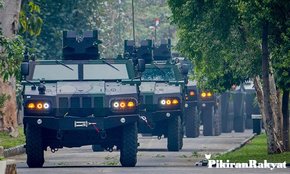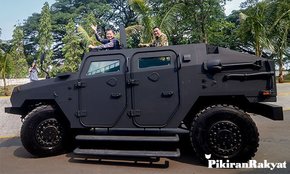I struggled to reply and waited a long time before going ahead, as earlier, I did not know how to explain it, without talking about TTPs in a long winded manner.
More importantly, a 90mm gun is easy to maintain for 365 deployment. As a plus, the rebels can’t steal a 90mm gun. ATGMs can be bought and sold. BTW, ATGMs especially the early generation ones were fragile. 10 to 30% would stop working after 1 year or less. Even modern ATGMs need good storage due to the optics and electronics — if you keep them in the field, you may need to check them throughout the life cycle.
A big 90mm gun does intimidate rebels and can be employed in a direct support role, if desperate. If the fight is urban, you need MBTS (otherwise it is misuse of armour assets) and supporting arms — especially mortars in an urban fight. As MBTS can’t be everywhere — takes up to a week to ship to remote locations — they are a stop gap.Just to add on what tonnyc comments on Badak 90mm. From what I gather from some Army officers, they envision the situations like insurgency just like they have faced in Aceh with GAM, Papua with OPM and East Timor with Fretilin..also they see potential urban insurgance scenario like Philippines faced in Mindanao.
More importantly, a 90mm gun is easy to maintain for 365 deployment. As a plus, the rebels can’t steal a 90mm gun. ATGMs can be bought and sold. BTW, ATGMs especially the early generation ones were fragile. 10 to 30% would stop working after 1 year or less. Even modern ATGMs need good storage due to the optics and electronics — if you keep them in the field, you may need to check them throughout the life cycle.
Same concept of operations — so no retraining to new doctrine is needed.They used to rely on Alvis Saladin/Saracen and V150 forces where the wheeled APC version being supported by wheeled Gun Support Armoured vehicles (like Alvis Saladin).
Armoured recce role, with a 90mm gun. Its more French in origin as a doctrine but still valid — if it suits the TNI context and terrain. The SAF has had to evolve our methods of war due to changes in our threat matrix, terrain and possible IO by enemy.Their concept seems using big gun support for tight urban areas or dense tropical Bushes where the insurgences take cover, while the APC's followed behind.
Ideally a battle group should have a good mix of weapons to deliver different effects. The 90mm gun can assist to break through strong points of rebel groups or act as a mobile armoured reserve to respond to counter attacks (i.e. reduce tactical options of rebel groups and reduce the chance of TNI units being over-run after a well planned rebel attack).This concept what they see as mobile infantry units operation. From my understanding this is going to be Anoa APC following this Badak in combat operation manouver.
Well I'm certainly not in possition to agree or not on their concept..but personally I do think their concept still following their experiences on using Alvis Saladin/Saracen and V150 during anti-insurgency operations, not what US, Russia, or NATO experiences in Afghanistan, Iraq or Syria recently, where 30mm fast reaction guns more preferable than bigger but slower rate 90mm.
Still, they do add 30mm gun to some armoured vehicles, like the picture you put on Komodo 4x4 with 30mm turret. I also saw pictures on local forums where Pindad put some models on their projects, in which there's model for IFV based on the hull of that medium tank they developed with FNSS. ThatbIFV used 30mm gun auto-turret.
Last edited:


